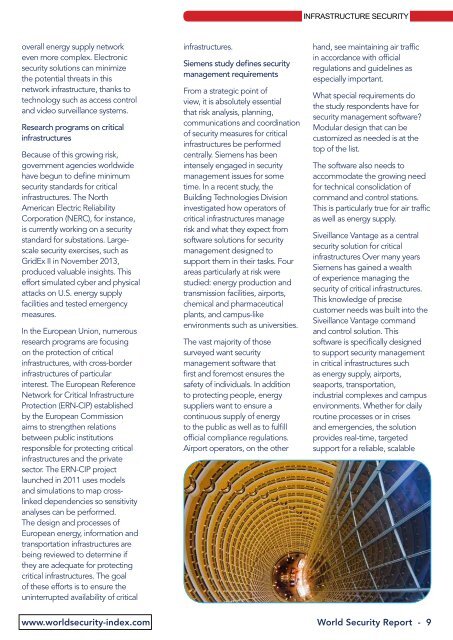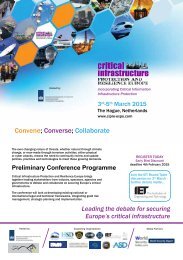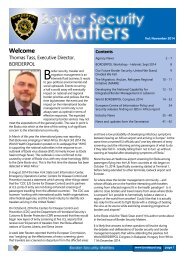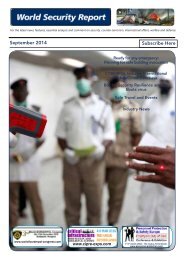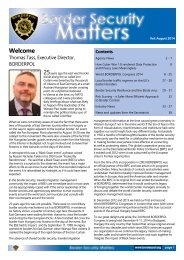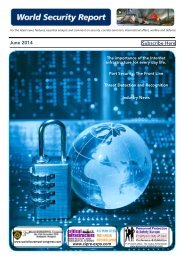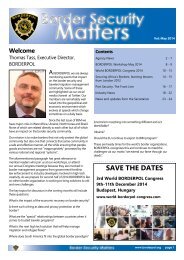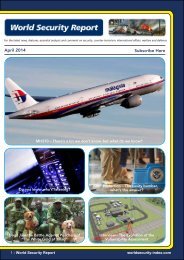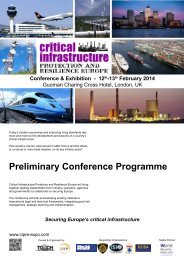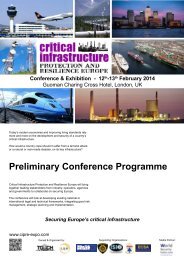World Security Report Jan 2015
World Security Report is a prime source of online information and analysis on security, counter-terrorism, international affairs and defence
World Security Report is a prime source of online information and analysis on security, counter-terrorism, international affairs and defence
Create successful ePaper yourself
Turn your PDF publications into a flip-book with our unique Google optimized e-Paper software.
INFRASTRUCTURE SECURITY<br />
overall energy supply network<br />
even more complex. Electronic<br />
security solutions can minimize<br />
the potential threats in this<br />
network infrastructure, thanks to<br />
technology such as access control<br />
and video surveillance systems.<br />
Research programs on critical<br />
infrastructures<br />
Because of this growing risk,<br />
government agencies worldwide<br />
have begun to define minimum<br />
security standards for critical<br />
infrastructures. The North<br />
American Electric Reliability<br />
Corporation (NERC), for instance,<br />
is currently working on a security<br />
standard for substations. Largescale<br />
security exercises, such as<br />
GridEx II in November 2013,<br />
produced valuable insights. This<br />
effort simulated cyber and physical<br />
attacks on U.S. energy supply<br />
facilities and tested emergency<br />
measures.<br />
In the European Union, numerous<br />
research programs are focusing<br />
on the protection of critical<br />
infrastructures, with cross-border<br />
infrastructures of particular<br />
interest. The European Reference<br />
Network for Critical Infrastructure<br />
Protection (ERN-CIP) established<br />
by the European Commission<br />
aims to strengthen relations<br />
between public institutions<br />
responsible for protecting critical<br />
infrastructures and the private<br />
sector. The ERN-CIP project<br />
launched in 2011 uses models<br />
and simulations to map crosslinked<br />
dependencies so sensitivity<br />
analyses can be performed.<br />
The design and processes of<br />
European energy, information and<br />
transportation infrastructures are<br />
being reviewed to determine if<br />
they are adequate for protecting<br />
critical infrastructures. The goal<br />
of these efforts is to ensure the<br />
uninterrupted availability of critical<br />
infrastructures.<br />
Siemens study defines security<br />
management requirements<br />
From a strategic point of<br />
view, it is absolutely essential<br />
that risk analysis, planning,<br />
communications and coordination<br />
of security measures for critical<br />
infrastructures be performed<br />
centrally. Siemens has been<br />
intensely engaged in security<br />
management issues for some<br />
time. In a recent study, the<br />
Building Technologies Division<br />
investigated how operators of<br />
critical infrastructures manage<br />
risk and what they expect from<br />
software solutions for security<br />
management designed to<br />
support them in their tasks. Four<br />
areas particularly at risk were<br />
studied: energy production and<br />
transmission facilities, airports,<br />
chemical and pharmaceutical<br />
plants, and campus-like<br />
environments such as universities.<br />
The vast majority of those<br />
surveyed want security<br />
management software that<br />
first and foremost ensures the<br />
safety of individuals. In addition<br />
to protecting people, energy<br />
suppliers want to ensure a<br />
continuous supply of energy<br />
to the public as well as to fulfill<br />
official compliance regulations.<br />
Airport operators, on the other<br />
hand, see maintaining air traffic<br />
in accordance with official<br />
regulations and guidelines as<br />
especially important.<br />
What special requirements do<br />
the study respondents have for<br />
security management software<br />
Modular design that can be<br />
customized as needed is at the<br />
top of the list.<br />
The software also needs to<br />
accommodate the growing need<br />
for technical consolidation of<br />
command and control stations.<br />
This is particularly true for air traffic<br />
as well as energy supply.<br />
Siveillance Vantage as a central<br />
security solution for critical<br />
infrastructures Over many years<br />
Siemens has gained a wealth<br />
of experience managing the<br />
security of critical infrastructures.<br />
This knowledge of precise<br />
customer needs was built into the<br />
Siveillance Vantage command<br />
and control solution. This<br />
software is specifically designed<br />
to support security management<br />
in critical infrastructures such<br />
as energy supply, airports,<br />
seaports, transportation,<br />
industrial complexes and campus<br />
environments. Whether for daily<br />
routine processes or in crises<br />
and emergencies, the solution<br />
provides real-time, targeted<br />
support for a reliable, scalable<br />
www.worldsecurity-index.com<br />
<strong>World</strong> <strong>Security</strong> <strong>Report</strong> - 9


